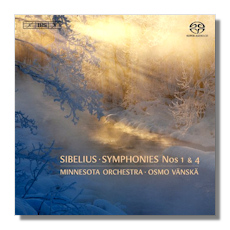
The Internet's Premier Classical Music Source
Related Links
- Sibelius Reviews
- Latest Reviews
- More Reviews
-
By Composer
-
Collections
DVD & Blu-ray
Books
Concert Reviews
Articles/Interviews
Software
Audio
Search Amazon
Recommended Links
Site News
 SACD Review
SACD Review
Jean Sibelius

- Symphony #1 in E minor, Op. 39
- Symphony #4 in A minor, Op. 63
Minnesota Orchestra/Osmo Vänskä
BIS SACD-1996 Hybrid Multichannel SACD 74:10
Osmo Vänskä is one of the world's greatest conductors of Sibelius, and he has an instrument in the Minnesota Orchestra that works very well with him. Why BIS approved his second Sibelius cycle is somewhat of a mystery to me, if only because his first with the Lahti Symphony Orchestra (also on BIS and coupled with all the composer's alternative versions) is seen as so fine. I've not heard it, but I've long admired and written at length on this team's outstanding Beethoven recordings. Alas, the Sibelius here is more uneven.
The name of the game seems to be contrast. Vänskä blasts through parts of the Symphony #1 in a way that would be tremendously exciting if it didn't feel so rushed. I still admire the unquestionable virtuosity and power of the Minnesota Orchestra, which follows its leader without hesitation. There are also moments that are quite a bit slower than the norm. Leonard Bernstein did some strange things with this music in his later Vienna Philharmonic reading, and while the present issue is not as bizarre, it's not quite as distinctive, either. The orchestra sounds absolutely lovely, so that's not the problem. Rather, I blame the conductor. What I liked most about his Beethoven was the utter lack of ego and sheer naturalness of the musical decisions. Here, and in the Symphony #1 especially, everything feels slightly micromanaged. Every phrase sounds a little bit different than the last, and while this is superficially exciting and initially interesting, others (including Vänskä himself) have allowed the music to say more while doing less on the podium.
Still, there are things to appreciate, not least the great sound that BIS provides. Also, faster sections are pretty thrilling (except in the places where the music either blurs or drags). Whatever Vänskä wants, the orchestra gives, and there are certainly some fine ideas. That seems to be the main problem; this is a disc of new ideas that (based on what I have read and briefly sampled) do not appear to supersede the conductor's previous ones. At least the Symphony #4 has more charm and subtlety, and is the better performance on the whole. Realistically, I don't hear quite as many of the negatives as more experienced writers, because I do agree with Vänskä's choices here and there. If you are curious, BIS' sound will allow you to analyze every detail. That appears to be what the conductor did to these scores, and whether that appeals to you or not will likely determine whether you respond to this disc or not.
Copyright © 2015, Brian Wigman





















